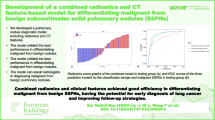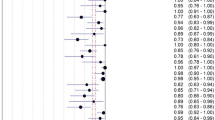Abstract
The objective is to explore the value of artificial intelligence (AI) diagnostic system-assisted CT examination combined with serum tumor markers in the diagnosis of benign and malignant pulmonary nodules. 150 patients with pulmonary nodules diagnosed and treated in our hospital from April 2021 to September 2022 were selected and divided into benign group (n = 48) and malignant group (n = 102) according to postoperative pathological examination results. Logistic regression analysis was applied to analyze relationships among clinical and imaging features as well as benign and malignant pulmonary nodules. To observe the diagnostic value of AI-assisted CT combined with serum tumor markers for benign and malignant pulmonary nodules. Results showed that the multi-variate Logistic regression analysis indicated that spicule sign, vascular convergence sign and calcification were risk factors for malignant pulmonary nodules (P < 0.05). The sensitivity (97.06%) and accuracy (91.33%) of serum tumor markers combined with CT in the diagnosis of benign and malignant pulmonary nodules were higher than those of each alone. The Kappa index of combined diagnosis was higher than that of single diagnosis. Kappa index = 0.793, which was in good consistency with pathological diagnosis results. The conclusion is that the sensitivity and accuracy of AI diagnostic system-assisted CT examination combined with serum tumor markers in the diagnosis of benign and malignant pulmonary nodules are high, which has perfect consistency with pathological diagnosis results.

Similar content being viewed by others
Data availability
The labeled dataset used to support the findings of this study are available from the corresponding author upon request.
References
Bai C, Choi CM, Chu CM, Anantham D, Chung-Man Ho J, Khan AZ, Yim A (2016) Evaluation of pulmonary nodules: clinical practice consensus guidelines for Asia. Chest 150(4):877–893. https://doi.org/10.1016/j.chest.2016.02.650
Bankier AA, MacMahon H, Goo JM, Rubin GD, Schaefer-Prokop CM, Naidich DP (2017) Recommendations for measuring pulmonary nodules at CT: a statement from the fleischner society. Radiology 285(2):584–600. https://doi.org/10.1148/radiol.2017162894
Cao W, Chen HD, Yu YW, Li N, Chen WQ (2021) Changing profiles of cancer burden worldwide and in China: a secondary analysis of the global cancer statistics 2020. Chin Med J (engl) 134(7):783–791. https://doi.org/10.1097/cm9.0000000000001474
Chamberlin J, Kocher MR, Waltz J, Snoddy M, Stringer NFC, Stephenson J, Burt JR (2021) Automated detection of lung nodules and coronary artery calcium using artificial intelligence on low-dose CT scans for lung cancer screening: accuracy and prognostic value. BMC Med 19(1):55. https://doi.org/10.1186/s12916-021-01928-3
Dongling L, Shoufang L, Guangfeng Y, Xiaofei L, Songpeng L (2019) Clinical value of combined determination of serum ProGRP, CEA, CYFRA211, NSE, CA199 and AFP in the diagnosis of lung cancer. Chin J Clin Lab ManagementElectron Ed 7(3):145–149
Fang R, Han H, Yang Y, Ma C, Xie B, Fu X, Wang D (2019) Clinical characteristics on low-dose high-resolution computed tomography and serum tumor markers of malignant pulmonary solid small nodules and postoperative survival analysis. J Buon 24(3):918–928
Groheux D, Quere G, Blanc E, Lemarignier C, Vercellino L, de Margerie-Mellon C, Querellou S (2016) FDG PET-CT for solitary pulmonary nodule and lung cancer: literature review. Diagn Interv Imaging 97(10):1003–1017. https://doi.org/10.1016/j.diii.2016.06.020
Guoqing X, Yiping H (2019) Study on the effect of serum neuron specific enolase and gastrin releasing peptide precursor levels in evaluating the efficacy and prognosis of small cell lung cancer. China General Med 22(35):4322–4326
Hui Y, Jia Q (2022) Diagnostic value of PET/CT combined with serum tumor markers detection for benign and malignant solitary pulmonary nodules. Chin J CT MRI 20(7):61–63
Huidong J, Qiang X, Jun L, Qingtao M, Xiaoxu Y (2022) Application of 64 slice CT combined with NSE and ProGRP in differential diagnosis and TNM staging of lung cancer. Chin J Modern Med 32(14):95–100
Kim J, Dabiri B, Hammer MM (2021) Micronodular lung disease on high-resolution CT: patterns and differential diagnosis. Clin Radiol 76(6):399–406. https://doi.org/10.1016/j.crad.2020.12.025
Li X, Zhang Q, Jin X, Cao L (2017) Combining serum miRNAs, CEA, and CYFRA21-1 with imaging and clinical features to distinguish benign and malignant pulmonary nodules: a pilot study: Xianfeng Li et al.: Combining biomarker, imaging, and clinical features to distinguish pulmonary nodules. World J Surg Oncol 15(1):107. https://doi.org/10.1186/s12957-017-1171-y
Li Y, Tian X, Gao L, Jiang X, Fu R, Zhang T, Yang D (2019) Clinical significance of circulating tumor cells and tumor markers in the diagnosis of lung cancer. Cancer Med 8(8):3782–3792. https://doi.org/10.1002/cam4.2286
Liu SJ, Zhao JY, Wang J (2022) Analysis of independent risk factors of non solid pulmonary nodules and establishment of benign and malignant prediction model. China Medical Herald 19(4):4
MacMahon H, Naidich DP, Goo JM, Lee KS, Leung ANC, Mayo JR, Bankier AA (2017) Guidelines for management of incidental pulmonary nodules detected on CT images: from the fleischner society 2017. Radiology 284(1):228–243. https://doi.org/10.1148/radiol.2017161659
Marmor HN, Jackson L, Gawel S, Kammer M, Massion PP, Grogan EL, Deppen SA (2022) Improving malignancy risk prediction of indeterminate pulmonary nodules with imaging features and biomarkers. Clin Chim Acta 534:106–114. https://doi.org/10.1016/j.cca.2022.07.010
Saiyin O, Haiwei X, Xiufa C, Lifeng S, Chen L, Jie F, Guangtao Y (2019) The Performance verification of a domestic gastrin-releasing peptide for chemiluminescence immunoreagent. Labeled Immunoassays Clin Med 26(8):1370–1374
Schabath MB, Cote ML (2019) Cancer progress and priorities: lung cancer. Cancer Epidemiol Biomarkers Prev 28(10):1563–1579. https://doi.org/10.1158/1055-9965.Epi-19-0221
Shan WL, Kong D, Zhang H, Zhang JD, Duan SF, Guo LL (2022) Clinical value of a differentiation prediction model for invasive lung adenocarcinoma. Zhonghua Zhong Liu Za Zhi 44(7):767–775. https://doi.org/10.3760/cma.j.cn112152-20200102-00002
Shi J, Liu X, Ming Z, Li W, Lv X, Yang X, Yang S (2021) Value of combined detection of cytokines and tumor markers in the differential diagnosis of benign and malignant solitary pulmonary nodules. Zhongguo Fei Ai Za Zhi 24(6):426–433. https://doi.org/10.3779/j.issn.1009-3419.2021.102.20
Ting Z, Bo X, Yongping L (2021) The predictive value of joint detection of tumor markers in the auxiliary diagnosis of lung cancer. Chin J Prevent Med 55(6):786–791
Villalobos P, Wistuba II (2017) Lung cancer biomarkers. Hematol Oncol Clin North Am 31(1):13–29. https://doi.org/10.1016/j.hoc.2016.08.006
Walter JE, Heuvelmans MA, Oudkerk M (2017) Small pulmonary nodules in baseline and incidence screening rounds of low-dose CT lung cancer screening. Transl Lung Cancer Res 6(1):42–51. https://doi.org/10.21037/tlcr.2016.11.05
Wei S, Shi B, Zhang J, Li N (2021) Differentiating mass-like tuberculosis from lung cancer based on radiomics and CT features. Transl Cancer Res 10(10):4454–4463. https://doi.org/10.21037/tcr-21-1719
White CS, Kazerooni EA (2020) Assessing pulmonary nodules by using lower dose at CT. Radiology 297(3):708–709. https://doi.org/10.1148/radiol.2020203501
Xiao F, Yu Q, Zhang Z, Liu D, Liang C (2019) Establishment and verification of a novel predictive model of malignancy for non-solid pulmonary nodules. Zhongguo Fei Ai Za Zhi 22(1):26–33. https://doi.org/10.3779/j.issn.1009-3419.2019.01.06
Xin J, Sichun H, Shaoheng W, Hongmei S, Jun H (2019) The clinical value of tumor markers in the diagnosis and prognosis prediction of lung cancer. Chin J Gerontol 39(4):811–814
Xiong Z, Zhou H, Hu CP, Liu JK, Chen H, Chen W, Zhu ZM (2013) Correlation between computed tomographic vascular convergence sign and enhancement value in patients with pulmonary nodules. Zhonghua Yi Xue Za Zhi 93(38):3015–3018
Yang D, Zhang X, Powell CA, Ni J, Wang B, Zhang J, Zhang L (2018) Probability of cancer in high-risk patients predicted by the protein-based lung cancer biomarker panel in China: LCBP study. Cancer 124(2):262–270
Yufeng G, Ting Z, Chao Z, Zhenwei X, Xiaona K, Xiaolin Z (2021) Bioinformatics analysis and antigen determinants prediction of ProGRP. Chin J Immunol 37(23):5
Zhang Y, Jiang B, Zhang L, Greuter MJW, de Bock GH, Zhang H, Xie X (2022) Lung nodule detectability of artificial intelligence-assisted CT image reading in lung cancer screening. Curr Med Imaging 18(3):327–334. https://doi.org/10.2174/1573405617666210806125953
Funding
None.
Author information
Authors and Affiliations
Corresponding author
Ethics declarations
Conflict of interest
The author declares no competing interests.
Ethical approval
The study was approved by the Institutional Review Board and Research Ethics Committee of the Shaanxi Provincial People’s Hospital, and was conducted in accordance to the tenets of the Declaration of Helsinki.
Informed consent
Informed consent was obtained from all individual participants included in the study.
Additional information
Publisher's Note
Springer Nature remains neutral with regard to jurisdictional claims in published maps and institutional affiliations.
Rights and permissions
Springer Nature or its licensor (e.g. a society or other partner) holds exclusive rights to this article under a publishing agreement with the author(s) or other rightsholder(s); author self-archiving of the accepted manuscript version of this article is solely governed by the terms of such publishing agreement and applicable law.
About this article
Cite this article
Fan, W., Liu, H., Zhang, Y. et al. Value of CT examination combined with serum tumor markers assisted with artificial intelligence diagnostic system in the diagnosis of benign and malignant pulmonary nodules. Soft Comput (2023). https://doi.org/10.1007/s00500-023-09249-8
Accepted:
Published:
DOI: https://doi.org/10.1007/s00500-023-09249-8




